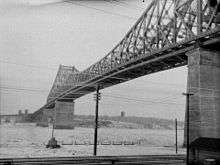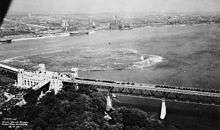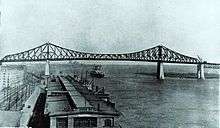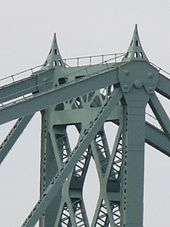Jacques Cartier Bridge
| Jacques Cartier Bridge Pont Jacques-Cartier | |
|---|---|
|
| |
| Coordinates | 45°31′15″N 73°32′06″W / 45.52083°N 73.53500°WCoordinates: 45°31′15″N 73°32′06″W / 45.52083°N 73.53500°W |
| Carries | Route 134 |
| Crosses | St. Lawrence River |
| Locale | Longueuil and Montreal, Quebec, Canada |
| Other name(s) | Montreal Harbour Bridge (1930-1934) |
| Owner | The Jacques Cartier and Champlain Bridges Inc. |
| Maintained by | The Jacques Cartier and Champlain Bridges Inc. |
| Website |
pontjacquescartierbridge |
| Characteristics | |
| Design | Cantilever bridge |
| Material | Steel |
| Total length |
2,725 m (8,940 ft) 3,425.6 m (11,239 ft) (including approaches)[1] |
| Width | 22 m (72 ft)[1] |
| Height | 104 m (341 ft)[1] |
| Longest span | 334 m (1,096 ft)[1] |
| Number of spans | 40[1] |
| Clearance below | 49.4 m (162 ft) at mid-span[1] |
| Number of lanes | 5 |
| History | |
| Designer | Philip Louis Pratley |
| Constructed by | Dominion Bridge Company |
| Construction begin | May 26, 1925 |
| Construction cost | C$23 million |
| Inaugurated | May 24, 1930 |
| Opened | May 14, 1930 |
| Statistics | |
| Daily traffic | 98,000[2] |
 | |
The Jacques Cartier Bridge (French: pont Jacques-Cartier) is a steel truss cantilever bridge crossing the Saint Lawrence River from Montreal Island, Montreal, Quebec to the south shore at Longueuil, Quebec, Canada. The bridge crosses Île Sainte-Hélène in the centre of the river, where offramps allow access to the Parc Jean-Drapeau and La Ronde amusement park.
Originally named the Montreal Harbour Bridge (pont du Havre), it was renamed in 1934[3] to commemorate the 400th anniversary of Jacques Cartier's first voyage up the St. Lawrence River.
The five-lane highway bridge is 3,425.6 m (11,239 ft) in length, including the approach viaducts. There are approximately 35.8 million vehicle crossings annually,[2] making it the third busiest bridge in Canada, the first being Champlain Bridge, just a few kilometres upstream. The second busiest bridge in Canada overall is the Port Mann Bridge in Metro Vancouver (connecting Surrey to Coquitlam).
Together with Champlain Bridge, it is administered by the Jacques Cartier and Champlain Bridges Incorporated (JCCBI), a Canadian Crown Corporation which reports to Infrastructure Canada.
History
Planning

Discussions began as early as 1874[4] about the construction of a new bridge to alleviate the congestion on Victoria Bridge, which was then a rail-only bridge, the wintertime ice bridge and the ferries used to connect the city to its south shore. The decision to build the bridge was made official in 1924.[4] The bridge was designed by engineer Philip Louis Pratley.
Construction

Construction was undertaken by the Dominion Bridge Company starting in 1925. On August 9, 1926 the cornerstone was laid, integrated into the pillar at the corner of Notre Dame Street and Saint Antoine Street, opposite the Pied-du-Courant Prison. The cornerstone contains a capsule with 59 items reflecting the year in which construction began. The bridge was constructed of steel at a cost of C$23 million, and the work lasted two and a half years.
The groundbreaking was held on May 26, 1925. Construction began immediately and the cornerstone was laid on August 9, 1926 on Pillar No. 26. The superstructure was built between September 1926 and September 1929. 33,000 tons of steel were needed for its construction. The work was completed about a year and a half ahead of schedule, without disrupting river traffic.
It opened to traffic on May 14, 1930, however the inauguration ceremony took place a few days later, on May 24. The bridge was inaugurated as the "Harbour Bridge" but was renamed "Jacques Cartier Bridge" in 1934, following a petition from citizens to honor the explorer who discovered Canada in 1534.
Modifications

The bridge was originally designed as a road, tramway, and pedestrian bridge. The original bridge had three lanes of road traffic and two sidewalks. Space in each direction was left free for the possible installation of two tramway lines. Tramway tracks were installed but never used. A parallel empty space used to exist to the right of the roadway in each direction, through which the bridge's girders could be seen.
The space on the east side was converted into an additional traffic lane in 1956, and on the west side in 1959, bringing the total capacity of the bridge to five lanes. The roadway was expanded by an additional traffic lane on the east side in 1956 and the west side in 1959[4] to include the space allocated to the tramway tracks, adding an extra lane of traffic in each direction. The two sidewalks were outside the bridge proper.
To accommodate large ships using the new St. Lawrence Seaway, the span over the east channel of the river (the Warren truss) was raised an additional 80 feet (24.4 m) (to 120 feet or 36.6 metres) in 1957 and 1958. Traffic flow over the bridge was uninterrupted by this construction, through the installation of two Bailey bridges.[4]
Originally, the bridge was constructed with only one ramp to Saint Helen's Island, located on the western side of the bridge. In 1961, a second ramp was built on the east side to prevent cars traveling to Montreal from having to cross the path of those heading toward Longueuil, a major source of accidents.
During 2001 and 2002 the entire deck of the bridge was replaced.[4] The sidewalks were also widened to a width of 8-foot (2.44 m), and the sidewalk on the western side of the bridge was made a bike path.
In 2004, a suicide prevention barrier was installed. Until then the bridge saw an average of 10 suicides a year.[5]
There are four 3-metre high finials, at the four high-points of the bridge, as architectural ornaments.[4] Their shape resembles the Eiffel Tower without being a replica.[4]

Inspiration

The bridge follows the general design concept of the Quebec Bridge. It was, in turn, one of the design influences for the Story Bridge, in Brisbane, Australia, which was completed in 1940.[6] Interestingly, its imposing steel structure of its main section most likely inspired the designers of J. C. Van Horne Bridge spanning the Restigouche River between Campbellton, New Brunswick and Pointe-à-la-Croix, Quebec. This bridge was not built until 1958.
Toll
The structure was a toll bridge from its opening until 1962[4] and a toll plaza was located on the southern approach. The toll plaza area now houses the offices of the corporation that owns and operates the structure and the nearby Champlain Bridge. Tokens were issued for part of the period that tolls were collected.
Disruptions
This bridge has been shut down several times due to several protesters who have individually climbed on the superstructure of the bridge or on a sign in the Longueuil side of the bridge. Two of them were from the Fathers for Justice group, while a third claimed he was part of the group. Recently, a man wearing a Canadian flag climbed the structure of the bridge. Most of the protests led to massive traffic congestion during rush hour. Recently, the pedestrian paths were modified with the installation of round metal fences all around in both directions, to disallow climbing of the superstructure and discourage potential suicide jumpers, the two main problems associated with pedestrian traffic on the bridge.
Gallery
 Jacques-Cartier Bridge, 1937
Jacques-Cartier Bridge, 1937 Jacques-Cartier Bridge from the Concorde Bridge
Jacques-Cartier Bridge from the Concorde Bridge- View from the bridge, before the suicide prevention barriers were installed
 Driving on the Jacques-Cartier bridge
Driving on the Jacques-Cartier bridge Jacques Cartier Bridge at dusk
Jacques Cartier Bridge at dusk- Signs inside the bridge
- Jacques Cartier Bridge
 West side view of the Jaques Cartier Bridge
West side view of the Jaques Cartier Bridge
See also
References
- 1 2 3 4 5 6 "Jacques Cartier Bridge: Technical Data". Bridges & Structures. The Jacques Cartier and Champlain Bridges Incorporated. Retrieved 6 December 2013.
- 1 2 http://jccbi.ca/bridges-structures/jacques-cartier-bridge/the-bridge/
- ↑ "The Jacques Cartier Bridge". The Jacques Cartier and Champlain Bridges Incorporated. Retrieved 2014-10-25.
- 1 2 3 4 5 6 7 8 "Jacques Cartier Bridge (QC 134)". Retrieved 2008-08-25.
- ↑ "La barrière anti-suicide a prouvé son utilité" (in French). Le Devoir. 2007-09-10. Retrieved 2008-08-25.
- ↑ Gregory, Helen (2007). Brisbane Then and Now. Wingfield, South Australia: Salamander Books. p. 92. ISBN 978-1-74173-011-1.
External links
- Official page
- Jacques Cartier Bridge at Structurae
- Steve Anderson's MontrealRoads.com: Jacques Cartier Bridge (QC 134)